
The United States Fish and Wildlife Service is an agency within the United States Department of the Interior dedicated to the management of fish, wildlife, and natural habitats. The mission of the agency is "working with others to conserve, protect, and enhance fish, wildlife, plants and their habitats for the continuing benefit of the American people."

The United States Fish Commission, formally known as the United States Commission of Fish and Fisheries, was an agency of the United States government created in 1871 to investigate, promote, and preserve the fisheries of the United States. In 1903, it was reorganized as the United States Bureau of Fisheries, sometimes referred to as the United States Fisheries Service, which operated until 1940. In 1940, the Bureau of Fisheries was abolished when its personnel and facilities became part of the newly created Fish and Wildlife Service, under the United States Department of the Interior.

USS Edithena was a United States Navy patrol vessel in commission from 1917 to 1919 that saw service during World War I. Prior to her U.S. Navy service, she operated as the private motor yacht Edithena from 1914 to 1917. After the conclusion World War I, she served as the fishery patrol vessel USFS Widgeon in the fleet of the United States Bureau of Fisheries from 1919 to 1940 and as US FWS Widgeon in the fleet of the Fish and Wildlife Service from 1940 to 1942. During World War II, she returned to U.S. Navy service from 1942 to 1944 as the yard patrol boat USS YP-200. By 1947 she had returned to private ownership, first as Edithena and during the 1970s and 1980s as the fishing vessel Ila Mae.

USS Teal (AM-23/AVP-5) was a Lapwing-class minesweeper acquired by the United States Navy for the task of removing naval mines from minefields laid in the water to prevent ships from passing. The ship entered service in 1918, was converted into a seaplane tender in the 1920s and took part in World War II, serving primarily in Alaskan waters. Following the war, the ship was decommissioned and sold in 1948. Teal was named after the teal, any of several small, short-necked, river ducks common to Europe and the Americas.
USS Halcyon (SP-518) was a United States Navy patrol vessel in commission from 1917 to 1919. She saw service during World War I and its immediate aftermath. After the conclusion of her naval service, she was in the United States Bureau of Fisheries fleet as the research vessel USFS Halcyon from 1919 to 1927.
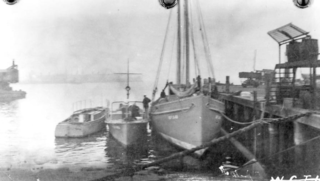
USS Wachusetts (SP-548) was an armed motorboat that served in the United States Navy as a patrol vessel from 1917 to 1919. She was renamed SP-548 during her period of service. In 1919 she was transferred to the United States Bureau of Fisheries and renamed USFS Fulmar, and operated as a fisheries science research vessel on the Great Lakes until 1933 or 1934, when she was transferred to the Ohio Division of Conservation.
Afognak Island State Park is a 75,047-acre (30,370 ha) Alaska state park on Afognak Island in Kodiak Island Borough, Alaska in the United States. Afognak Island is northeast of Kodiak Island on the Alaska Peninsula. Most of Afognak Island State Park is undeveloped. The park is known for its rugged topography and wide variety of wildlife. Afognak Island State Park is open to year-round recreation, including fishing, hunting, and hiking. Transportation is provided by float plane from Kodiak to various areas around the park. It is on the northern and eastern ends of the island and surrounds Perenosa, Seal and Tonki Bays. It borders part of Kodiak National Wildlife Refuge to the west.

USS Raeo (SP-588) was a United States Navy patrol vessel in commission from 1917 to 1919. Prior to her U.S. Navy service, she operated as the motor passenger vessel Raeo from 1908 to 1917. After the conclusion of her U.S. Navy career, she served as the fishery patrol vessel USFS Kittiwake in the United States Bureau of Fisheries fleet from 1919 to 1940 and as US FWS Kittiwake in the Fish and Wildlife Service fleet from 1940 to 1942 and from 1944 to at least 1945, and perhaps as late as 1948. During World War II, she again served in the U.S. Navy, this time as the yard patrol boat USS YP-199. She was the civilian fishing vessel Raeo from 1948 to 1957, then operated in various roles as Harbor Queen from 1957 to 1997. She became Entiat Princess in 1998 and as of 2009 was still in service.

USS Cobra (SP-626) was a United States Navy patrol vessel in commission from 1917 to 1919 that operated during World War I. She originally was constructed as a private motorboat. After the conclusion of her U.S. Navy career, she served as the fishery patrol vessel USFS Petrel for the United States Bureau of Fisheries from 1919 to 1934, operating in the waters of the Territory of Alaska.

The second USS Calypso (SP-632) was a United States Navy patrol vessel in commission from 1917 to 1919. She originally operated as the private motorboat Calypso from 1909 to 1917. After the conclusion of her U.S. Navy career, she served as the fishery patrol vessel in the United States Bureau of Fisheries fleet from 1919 to 1940 as USFS Merganser and in the Fish and Wildlife Service fleet as US FWS Merganser from 1940 to 1942.

USFS Penguin was an American cargo liner in commission in the fleet of the United States Bureau of Fisheries from 1930 to 1940 and, as US FWS Penguin, in the fleet of the U.S. Fish and Wildlife Service from 1940 to 1950. She ran a passenger-cargo service between Seattle, Washington, and the Pribilof Islands, and provided transportation between the two inhabited Pribilofs, Saint Paul Island and St. George Island. She also carried passengers, supplies, and provisions to destinations on the mainland of the Territory of Alaska and in the Aleutian Islands. She occasionally supported research activities in Alaskan waters and the North Pacific Ocean.

USFS Eider was an American motor schooner in commission in the fleet of the United States Bureau of Fisheries from 1919 to 1940 and, as US FWS Eider, in the fleet of the U.S. Fish and Wildlife Service from 1940 to 1942 and again in the late 1940s. She ran a passenger-cargo service between Unalaska and the Pribilof Islands, and also carried passengers, supplies, and provisions to destinations on the mainland of the Territory of Alaska and in the Aleutian Islands. She occasionally supported research activities in Alaskan waters and the North Pacific Ocean, and she conducted patrols to protect Alaskan fisheries and marine mammals. In 1924, she provided logistical support to the first aerial circumnavigation of the world.

USFS Auklet was an American fishery patrol vessel that served in the waters of Southeast Alaska. She was in commission in the United States Bureau of Fisheries from 1917 to 1940 and in the U.S. Fish and Wildlife Service as US FWS Auklet from 1940 to 1950.
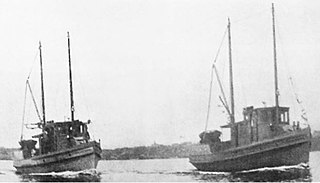
USFS Murre was an American fishery patrol vessel that served in the waters of Southeast Alaska. She was in commission in the United States Bureau of Fisheries fleet from 1917 to 1940 and, as US FWS Murre in the U.S. Fish and Wildlife Service fleet from 1940 to 1942. Murre and her sister ship USFS Auklet were the first vessels ever constructed for fisheries enforcement duties in Alaska.
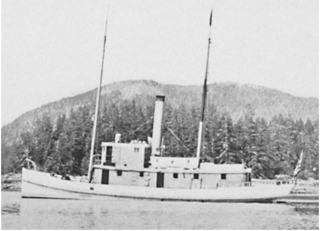
USFS Osprey was an American steamer that served as a fishery patrol vessel in the waters of the Territory of Alaska. She was in commission in the United States Bureau of Fisheries (BOF) from 1913 to 1921, and was the first vessel the BOF ever operated on fishery patrols in Alaska. Before the BOF purchased her, she was the commercial cannery tender Wigwam from 1895 to 1912. After her BOF career ended, she operated as a commercial motor tug with the name Foss No. 19 from 1922 to 1965 and with the name Kiowa from 1965 until she sank in 1978.

USFS Crane was an American fishery patrol vessel that operated in the waters of the Territory of Alaska. She was in commission in the United States Bureau of Fisheries (BOF) fleet from 1928 to 1940. She then served as US FWS Crane in the fleet of the Fish and Wildlife Service from 1940 to 1960. After a brief stint in the fleet of the Alaska Department of Fish and Game during 1960, she was sold into private service, at various times named Crane, Brapo, Fishing 5, Belle, and Patricia during the 1960s and 1970s and then again Crane since 1978. She remained in service as of 2020.

USFS Teal was an American fishery patrol vessel that operated in the waters of the Territory of Alaska. She was part of the fleet of the United States Bureau of Fisheries (BOF) fleet from 1928 to 1940. She then served as US FWS Teal in the fleet of the Fish and Wildlife Service from 1940 to 1960. After a stint in the fleet of the Alaska Department of Fish and Game from 1960 to 1966, she was sold into private service, and remained in operation as of 2016.
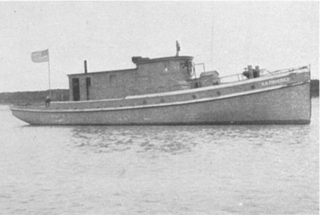
USFS Scoter was an American fishery patrol vessel that operated in the waters of the Territory of Alaska. She was part of the United States Bureau of Fisheries (BOF) fleet from 1922 to 1940. She then served as US FWS Scoter in the fleet of the Fish and Wildlife Service from 1940 to 1950. Before her United States Government service, she was the commercial purse seiner Clatsop. She returned to that name and to private ownership after the conclusion of her U.S. Government career.
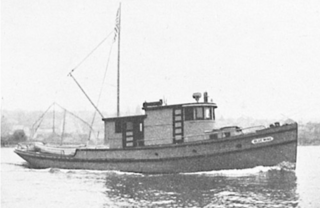
USFS Blue Wing was an American fishery patrol vessel that operated in the waters of the Territory of Alaska. She was part of the United States Bureau of Fisheries (BOF) fleet from 1924 to 1940. She then served as US FWS Blue Wing in the fleet of the Fish and Wildlife Service from 1940 until at least 1951. Before her United States Government service, she was the commercial purse seiner August. In private ownership after the conclusion of her U.S. Government career she was renamed El Don.

USFS Brant was an American fishery patrol vessel that operated in the waters of the Territory of Alaska and off Washington, California, and Mexico. She was part of the United States Bureau of Fisheries (BOF) fleet from 1926 to 1940. She then served as US FWS Brant in the fleet of the Fish and Wildlife Service from 1940 to 1953. She then operated commercially until she sank in 1960.


















